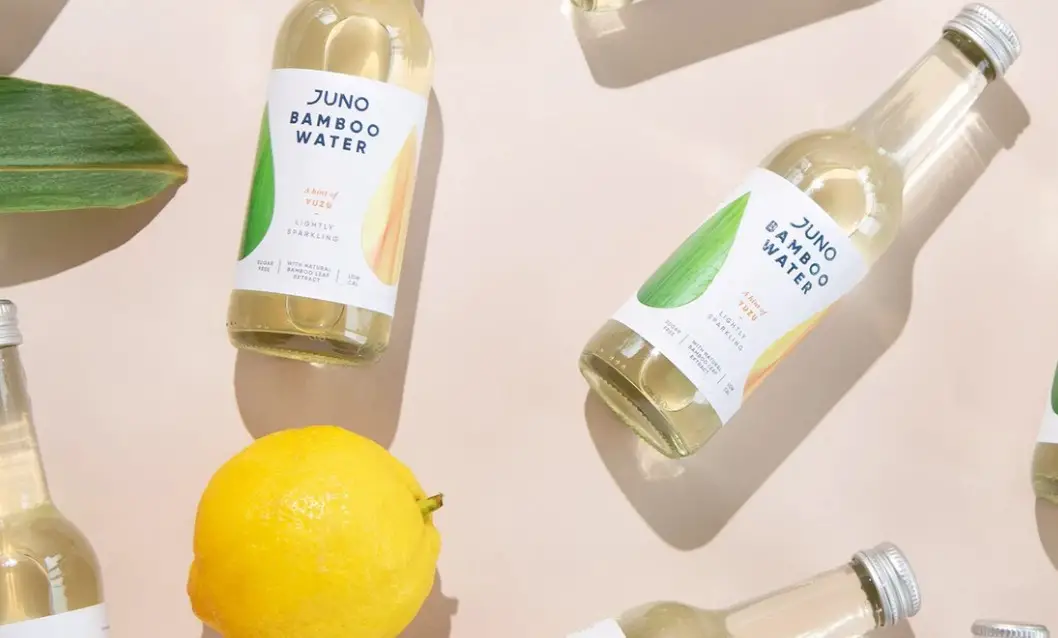Just when you thought they’d done everything with bamboo, along comes something new. And they’ve finally done it, they’ve combined two things that I can’t live without: bamboo and water. Yes, you already knew you could eat it, sleep in it, wear it, and build a house from it. Should we be surprised then, that we can also drink bamboo water?
Juno Bamboo Water is a new product that blends the nutritional benefits of bamboo leaves with the refreshing taste of yuzu fruit in a low-calorie beverage. Fresh bamboo leaves are an excellent source of silica, a trace mineral that the body uses to build collagen and revitalize connective tissues. The leaves are also a plentiful byproduct of a flourishing, sustainable bamboo farm. And the Juno Bamboo Water company furthers its pledge to the environment by using plastic-free packaging and supporting global reforestation efforts.
What is Bamboo Water?
First things first. Bamboo water is actually bamboo-infused water. Bamboo is a grass, but bamboo water is not like wheatgrass juice. You can’t just squeeze and press the bamboo until a green liquid comes out.
Juno Bamboo Water is essentially a lightly-sparkling bottled water with a little something extra. The drink contains 1.5 percent yuzu juice, from the Asian citrus fruit. This adds a hint of lemon flavor and a special sense of refreshment. It also gives the water an exotic aspect and another link to the Far East.
The key ingredient, naturally, is the bamboo, added in the form of an extract from the bamboo leaves. The flavor of the bamboo itself is subtle and earthy, easily overpowered by just a trace of yuzu. But the leaves’ nutritional properties are significant, being especially high in silica and antioxidants.
Visitors to this website should already be familiar with bamboo’s incredible versatility and sustainability. And of course, this is part of Juno Bamboo Water’s appeal. Bamboo, after all, has become an icon of environmental stewardship.
And in keeping with this philosophy, Juno is committed to using no plastic. Their bamboo water comes in a glass bottle which we encourage you to recycle. In addition, Juno has partnered with the non-profit organization One Tree Planted. For each bottle of Juno enjoyed, they make a donation to global reforestation projects.
Properties and benefits of bamboo leaves
We’ve discussed the heath benefits of bamboo leaves previously, in our article on Bamboo Leaves and Silica. Their most noteworthy characteristic is the high silica content.
Bamboo leaves contain about 70 percent silica, an essential mineral ordinarily found in quartz, sandstone, and other rocks. Silica is an important trace mineral that the human body uses to build healthy skin, bones, joints, and cartilage. The silica in bamboo is easily extractable by soaking the leaves in hot or cold water, like tea.
According to nutritionist Rosie Millen, bamboo leaf extract also contains a host of vitamins and minerals, including niacin, vitamin A, vitamin B6, and vitamin E. The B vitamins are crucial for cellular energy and vitamin E is a powerful antioxidant. Traces of vitamin C, selenium, and zinc are present as well, and important for the body’s natural immune functions.
Also, take a look at our article on Bamboo in Chinese Medicine.

Water Bamboo
Finally, we mustn’t mix up bamboo water with water bamboo. I know right? The more you learn about bamboo the more confusing it gets.
Phyllostachys heteroclada is a species of temperate, running bamboo often referred to as Water Bamboo. It has a nearly solid stem, and unlike most varieties, it can survive in very wet, saturated soil. The secret to its success are the small air canals in its roots and culms which allow the plant to breathe even in waterlogged soil. Water Bamboo can live for several days in these conditions, but eventually, the soil will require drainage. Not even Water Bamboo can grow directly in a pond or a marsh for prolonged periods.
Its vigorous growth habit makes P. heteroclada an ideal candidate for privacy screens, especially in very cold or wet areas. The canes grow up to 15 or 20 feet tall, normally not more than 1 inch in diameter. It is also a very cold-tolerant species, hardy down to -5º or -10º F. Be aware that some bamboo nurseries list it as Phyllostachys purpurata or Solid-stem bamboo.
Bamboo is thicker than water
If you enjoyed reading about bamboo water and water bamboo, you will love learning about the multitudes of other uses for bamboo. Check out some of these popular articles.

























